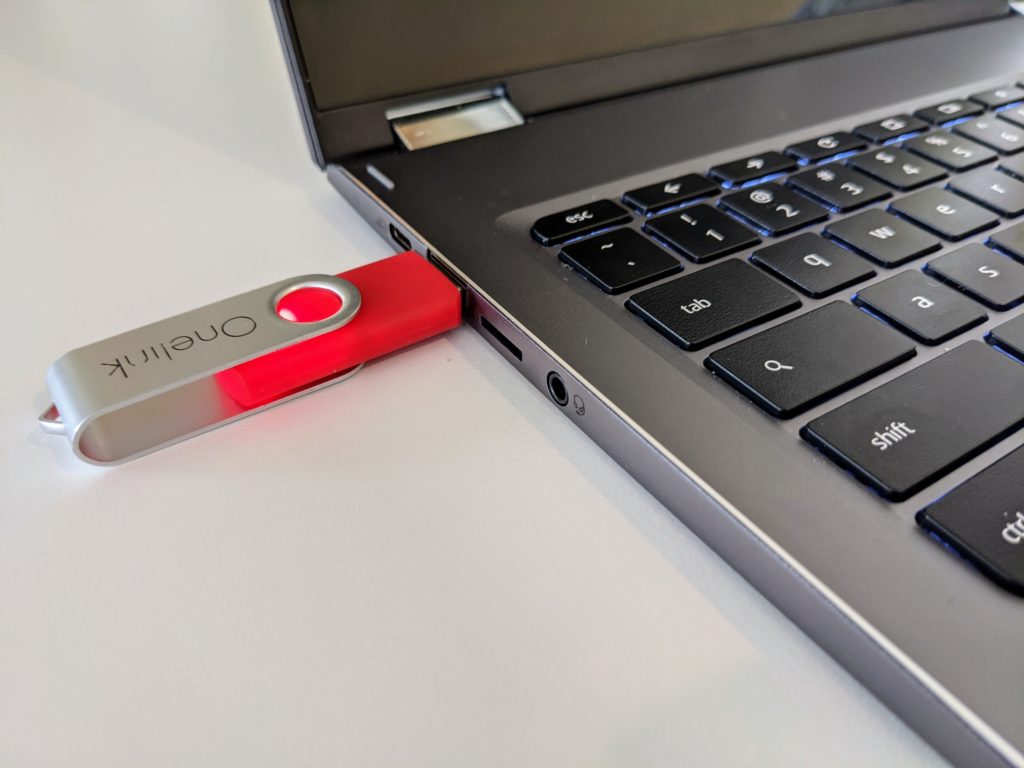If you have a Chromebook with a fairly meager 16 or 32 GB of storage, running Linux through Project Crostini may not be an option due to limited local storage. Back in 2018, Google realized this and started work on allowing Linux to run from an external drive connected to a Chromebook. After a year of silence, work has recently resumed on this feature; several code updates moving the effort forward have been committed in the last few months.

Assuming this change goes forward, it could let some otherwise Crostini-capable Chromebooks with limited storage space run the virtual machine for Linux on a USB-drive or even an SD memory card. You’ll want fast media in either case if you get the chance to try this; running a virtual machine with a Linux container on slower media wouldn’t be optimal.
Although I see the potential need for this on Chromebooks with smaller internal drives, it could benefit all Chromebooks users.
For example, you might have 64 or more GB of storage capacity on your device but perhaps you’re using the majority of it just for Chrome OS, Android apps and file storage. It would be handy to just whip out a USB drive with your Linux instance, boot up and do whatever you need to in the virtual machine.

Or maybe you have different Linux containers set up for different purposes: one for work and one for general purpose. Either way, having this flexibility could be beneficial.
Of course, given that Google is very focused on keeping Chrome OS secure, implementing Linux and VM support on external drives does bring some challenges. There has been developer chatter on how to best keep the environment secure while also bringing this external drive feature.
The last relevant commentary on the security aspect was to “allow extra disks only on untrusted VMs”, but that may not be a bad thing.

Recently, we’ve seen progress on allowing such VMs and those have led to the ability to install Windows 10 in a virtual machine on a Chromebook. In theory, one could run any operating system within such an untrusted VM with the only caveat being that it may not have full access to all hardware and software on your Chromebook.
At the moment, there’s no target version of Chrome OS for this feature, so if it does get implemented, it’s surely out several months yet.



13 Comments
How about running Linux natively on Chromebook and not just in a VM? Not possible, right? The limitations of ChromeOS, especially with file operations, are a major problem for me.
That’s been possible for about 6 years, provided you’re willing to put your Chromebook in Developer Mode. https://github.com/dnschneid/crouton
Then why did you buy a Chromebook?
It was so cheap!
That, and I like the concept, at least in part. But the ability to easily perform file operations turns out to be really important, and an online-only computer just doesn’t cut it. I have to wonder about the philosophy behind this machine, and about the long-term strategy on the part of Google in redefining the experience of using a computer to such a degree. I’m afraid it’s ultimately all about $$, since that tends to be such a major factor in technological direction: that which makes more money for the big corporations is the way things go, not what is better for the billions of people who must use the technology.
“It would be handy to just whip out a USB drive with your Linux instance, boot up and do whatever you need to in the virtual machine.”
I’ve never run Linux. But, given the freedom to physically ‘decouple’ the Linux OS storage from the Chromebook so that I could literally unplug it, I’d be much more comfortable experimenting with it. I actually hope that Google does this. Though, Googles Chrome OS developers have a lot of irons in the fire right now.
Ummmmmmm…….. I kinda run Linux on my micro sd card on my chromebook and have done for about a year xD
How did you do this?
Galliumos
Any idea if the performance would be good enough for regular use? I’ve briefly experimented with running various Linux distros from USB sticks on a regular PC, and the performance was always a big drag. Maybe that’s because I was just using any old USB stick?
Tried to post this question earlier, but it didn’t work apparently. What will the performance of Linux on a stick be like on a Chromebook? I’ve tried this with regular PCs and the performance was not good, but maybe that’s because I didn’t use the right USB stick.
Being able to run a Windows 10 VM this way for those small number of “gotta have” programs that only run in Windows would be very cool if it could run fast enough to be usable. The host Chromebook would probably have to have at least 8Gb of RAM to do this.
I also like the notion that a Linux distro could be run this way given that Crostini has limitations, and the typical CB hardware has limitations (no up-gradability).
This would be really useful since my current Chromebook only has 16 gb of space, 7 gb used by ChromeOS itself. Installing only just a few programs fills up the space quite quickly, and my Chromebook can’t easily upgrade it’s storage.
It would also be cool to have a tutorial on this, as im having issues following the steps provided in the issue.